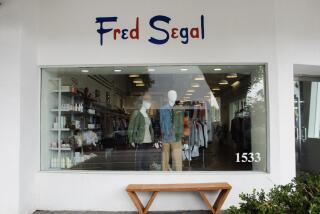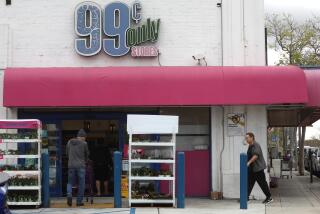Nasty Gal, once a fashion world darling, is now bankrupt. What went wrong?
- Share via
By 2012, Nasty Gal was a fashion world success story, growing from an Ebay store to nearly $100 million in sales in just six years.
Founder and Chief Executive Sophia Amoruso was Nasty Gal’s best model, embodying the Los Angeles company’s edgy-and-feminine aesthetic and attracting flurries of laudatory coverage with her rags-to-riches story.
But now Amoruso is gone and Nasty Gal is days away from a $20-million sale to British online retailer Boohoo.com. The transaction, which comes after a November filing for Chapter 11 bankruptcy protection, is expected to close Feb. 28.
Boohoo will acquire Nasty Gal’s intellectual property and says it plans to operate Nasty Gal as a standalone website. In a statement, it lauded Nasty Gal’s “extremely distinctive style” and “loyal customer base” — which will both complement Boohoo and expand “global opportunities for growth.”
So what went wrong at Nasty Gal?
Wasn’t the company growing rapidly?
Nasty Gal enjoyed tremendous growth in its early years, but at a heavy cost.
By 2011, its annual sales hit $24 million, an 11,200% jump from three years earlier, the company said publicly. Sales leap-frogged again in 2012 to nearly $100 million.
But it wasn’t long before sales started dropping — to $85 million in 2014, and then $77 million in 2015, according to bankruptcy documents. (In a stark example of appearance versus reality, Forbes magazine predicted that its 2015 sales would top $300 million).
Why did sales start to drop?
Analysts said that Nasty Gal’s rapid growth was fueled by heavy spending in advertising and marketing. It’s a strategy that many start-ups use, but one that only pays off in the long-run if one-time buyers become loyal shoppers.
“You end up spending money via marketing online like banner ads [or paying] influencers,” said Ari Bloom, chief executive of Avametric, a fashion software company in San Francisco, and an investor in fashion start-ups. “If you spend $50 on marketing to get a customer to buy something and they only buy once from you, you are probably not making money.”
In Nasty Gal’s case, the inability to hold on to customers led to what’s called “a leaky bucket” situation, analysts said. Once the company burned through its fundraising capital and slowed down on marketing, sales began falling in 2014 and continued to drop.
“When they turned that spending off, the growth vastly declined and revenue went down,” said Richie Siegel, founder of Loose Threads, a media company focused on fashion and technology. “I can spend $200 million to make $100 million in revenue, but that” doesn’t make for a sustainable business.
Why couldn’t they the company hold on to shoppers?
Some customers found the product quality to be lacking. Many others were simply more enticed by fast-fashion retailers such as Zara and H&M, which both delivery a wider array of trendy clothes to online and bricks-and-mortar stores with military precision.
There was also a ceiling to the number of women Nasty Gal appealed to; the specificity of its brand helped the company grow — but only to a point.
“Nasty Gal is a California cool, young girl thing,” Siegel said, “and it was very unclear how much it was attractive around the country and around the world.”

Any other growing pains?
Nasty Gal wasted money on things that didn’t warrant big expenditures.
Nasty Gal quintupled the size of its headquarters by moving into a 50,300-square-foot location in downtown Los Angeles in 2013. The offices — while a gorgeous showstopper visually — were far more space than the company needed, industry experts said.
The company also opened a 500,000-square-foot fulfillment center in Kentucky to handle its own distribution and logistics. And the once online-only retailer opened two bricks-and-mortar stores, in Los Angeles and Santa Monica.
In the ultra-competitive trendy fashion business, companies have to be operationally savvy to move products at a scale big enough to make a profit. Nasty Gal’s mostly young staff focused heavily on the creative side instead of the business side, Siegel said.
Those moves placed financial strain on the company without contributing much to its bottom line, industry watchers said (Boohoo did not buy the two stores, which are expected to close soon). Nasty Gal also informed the state of Kentucky that it planned to close the fulfillment center and lay off its 70 employees there by April 10.
It sounds like it burned through a lot of cash
In its bankruptcy filing, Nasty said it is facing “significant liquidity issues,” along with “strained” relationships with its vendors that have hampered the flow of merchandise.
In the last couple of years, the company has taken on several loans, including a $15-million loan in November 2015 and a $5-million convertible note last year. Although the company said it was current on its debts, those interest payments probably ate heavily into its available cash.
Nasty Gal said it had tried to raise additional capital but was unsuccessful, according to bankruptcy documents.
What about Amoruso?
Amoruso has proven both an asset and liability to the company she founded, analysts said.
As Nasty Gal expanded, Amoruso’s own fame grew — and with it, her attention to other projects. She penned two books — her first, “#Girlboss,” which delved into the founding of Nasty Gal and her business philosophy, has been adapted by Netflix into a show that launches this year. Amoruso served as executive producer.
Amoruso went on tour to promote the release of both of her books, and again when the paperback version of “#Girlboss” came out in 2015. Employees have complained about her management style and lack of focus, with workers rating Nasty Gal 2.7 out of five stars on employment site Glassdoor.
In 2015, Amoruso stepped down as chief executive, although she remained on as executive chairwoman (a role she resigned from last year when Nasty Gal filed for bankruptcy). In her wake, high-profile executives have come and gone, and the company has gone through several rounds of layoffs.
Nasty Gal is a prime example of how a company so intimately linked to its founder can often flail when that founder leaves — or when her attention splinters to other ventures. Amoruso’s backing away from Nasty Gal as its fortunes slid also sent the wrong signal to investors or potential investors, experts said.
“It was a big captain abandoning the ship as it’s sinking,” Siegel said. “She seemed to have prioritized her own brand over the company she helped build.”
In the end, analysts said Nasty Gal was killed by many of the same factors that has caused other start-ups to falter, including Birchbox and Gilt Groupe.
“It’s very hard to scale an e-commerce brand,” Bloom said. “The problems that Nasty Gal had were not unique to them in this space.”
Follow Shan on Twitter @ByShanLi
ALSO
Factory CEOs tell Trump: Jobs exist, skilled applicants don’t
Google spinoff Waymo accuses Uber of self-driving car theft
Disney cuts about 80 jobs in digital media unit that includes Maker Studios
More to Read
Inside the business of entertainment
The Wide Shot brings you news, analysis and insights on everything from streaming wars to production — and what it all means for the future.
You may occasionally receive promotional content from the Los Angeles Times.











